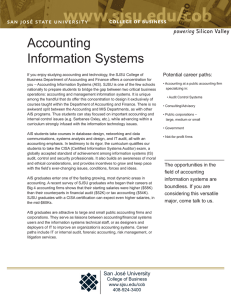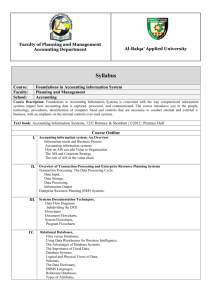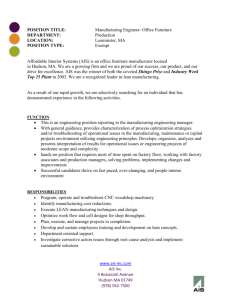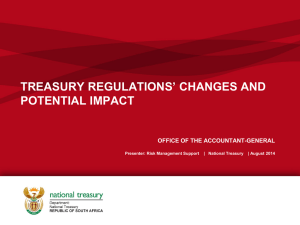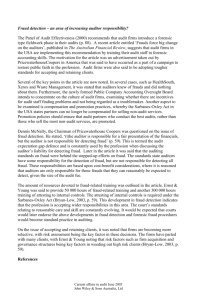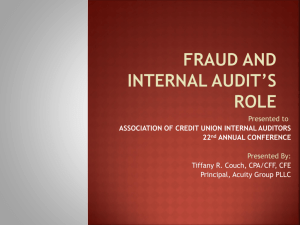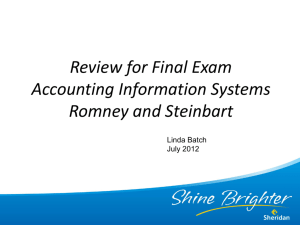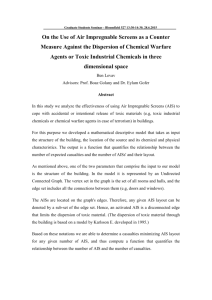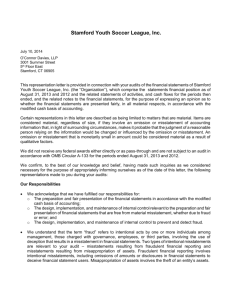Chapter Outlines
advertisement
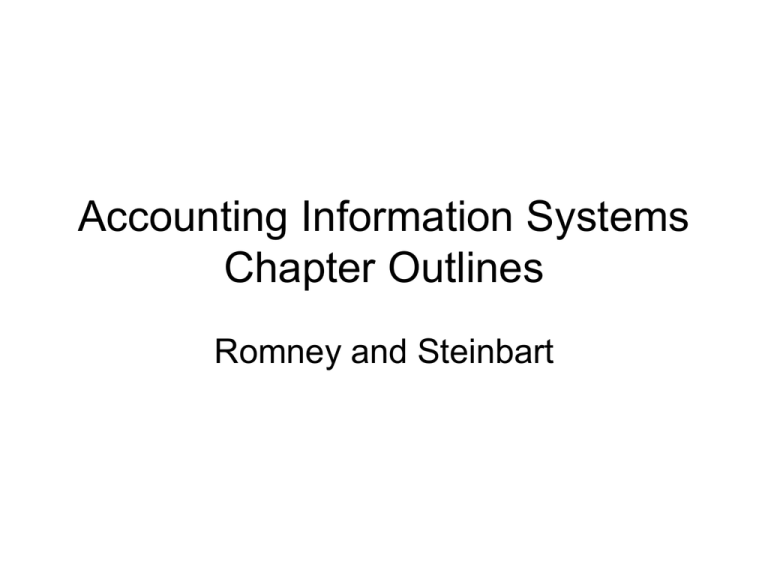
Accounting Information Systems Chapter Outlines Romney and Steinbart Chapter 1: Accounting Information Systems: An Overview • Learning Objectives – Distinguish between data and information, discuss the characteristics of useful information, and explain how to determine the value of information. – Explain what an accounting information system (AIS) is and describe the basic functions it performs. – Discuss why studying accounting information systems is important. – Explain the role an AIS plays in a company’s value chain and discuss how the AIS can add value to a business. Chapter 2: Overview of Business Processes • Learning Objectives – Explain the basic activities companies engage in, the types of decisions they must make, and the types of information they need to make those decisions. – Identify the major internal and external parties that an AIS interacts with and the type of information it provides each user. – Describe the major transaction cycles present in most companies. – Describe the four major steps in the data processing cycle and the major activities in each. Chapter 3: Systems Development and Documentation Techniques • Learning Objectives – Prepare and use data flow diagrams to understand, evaluate, and design information systems. – Prepare and use flowcharts to understand, evaluate, and design information systems. Chapter 4: Relational Databases • Learning Objectives – Explain the importance and advantages of databases, as well as the difference between database and filebased legacy systems. – Explain the difference between logical and physical views of a database. – Explain fundamental concepts of database systems such as DBMS, schemas, the data dictionary, and DBMS languages. – Describe what a relational database is and how it organizes data. Chapter 5: Computer Fraud and Abuse • Learning Objectives – Define fraud and describe the process one follows to perpetuate a fraud. – Discuss who perpetrates fraud and why it occurs, including the pressures, opportunities, and rationalizations that are present in most frauds. – Define computer fraud and discuss the different computer fraud classifications. – Compare and contrast the approaches and techniques that are used to commit computer fraud. Chapter 6: Control and Accounting Information Systems • Learning Objectives – Explain basic control concepts and why computer control and security are important. – Compare and contrast the COBIT, COSO, and ERM control frameworks. – Describe the major elements in the internal environment of a company. – Describe the four types of control objectives that companies need to set. – Describe the events that affect uncertainty and the techniques used to identify them. – Explain how to assess and respond to risk using the Enterprise Risk Management model. Chapter 7: Information Systems Controls for Systems Reliability– Part 1: Information Security • Learning Objectives – Explain how information security affects systems reliability. – Identify the four criteria that can be used to evaluate the effectiveness of an organization’s information security. – Explain the time-based model of security and the concept of defense-in-depth. – Describe the various types of preventive, detective, and corrective controls used to provide information security. – Explain how encryption contributes to security and how the two basic types of encryption systems work. Chapter 8: Information Systems Controls for System Reliability–Part 2: Confidentiality, Privacy, Processing Integrity, and Availability • Learning Objectives – Identify and explain controls designed to protect the confidentiality of sensitive corporate information. – Identify and explain controls designed to protect the privacy of customers’ personal information. – Identify and explain controls designed to ensure processing integrity. – Identify and explain controls designed to ensure systems availability. Chapter 9: Auditing ComputerBased Information Systems • Learning Objectives – Describe the scope and objectives of audit work, and identify the major steps in the audit process. – Identify the objectives of an information system audit, and describe the four-step approach necessary for meeting these objectives. – Design a plan for the study and evaluation of internal control in an AIS. – Describe computer audit software, and explain how it is used in the audit of an AIS. – Describe the nature and scope of an operational audit.

